2015年高考英语-全国卷I卷英语试题与标准答案-
2015年高考真题英语全国卷(新课标I卷)精教版含答案
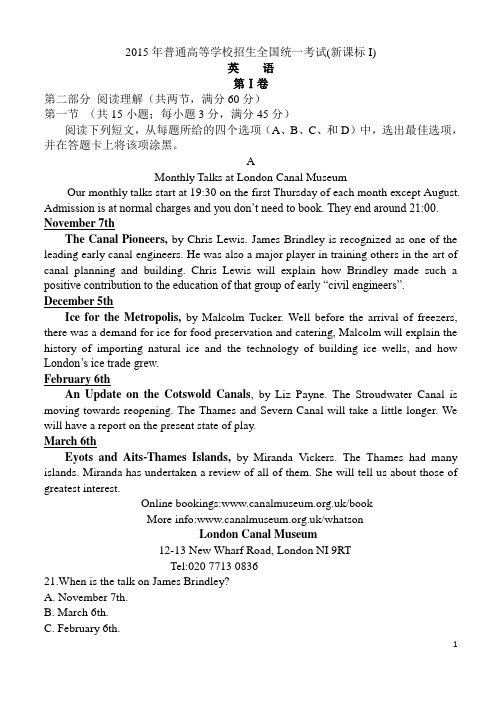
2015年普通高等学校招生全国统一考试(新课标I)英语第Ⅰ卷第二部分阅读理解(共两节,满分60分)第一节(共15小题;每小题3分,满分45分)阅读下列短文,从每题所给的四个选项(A、B、C、和D)中,选出最佳选项,并在答题卡上将该项涂黑。
AMonthly Talks at London Canal MuseumOur monthly talks start at 19:30 on the first Thursday of each month except August. Ad mission is at normal charges and you don‟t need to book. They end around 21:00. November 7thThe Canal Pioneers, by Chris Lewis. James Brindley is recognized as one of the leading early canal engineers. He was also a major player in training others in the art of canal planning and building. Chris Lewis will explain how Brindley made such a positive contribution to the education of that group of early “civil engineers”. December 5thIce for the Metropolis,by Malcolm Tucker. Well before the arrival of freezers, there was a demand for ice for food preservation and catering, Malcolm will explain the history of importing natural ice and the technology of building ice wells, and how London‟s ice trade grew.February 6thAn Update on the Cotswold Canals, by Liz Payne. The Stroudwater Canal is moving towards reopening. The Thames and Severn Canal will take a little longer. We will have a report on the present state of play.March 6thEyots and Aits-Thames Islands,by Miranda Vickers. The Thames had many islands. Miranda has undertaken a review of all of them. She will tell us about those of greatest interest.Online bookings:/bookMore info:/whatsonLondon Canal Museum12-13 New Wharf Road, London NI 9RTTel:020 7713 083621.When is the talk on James Brindley?A. November 7th.B. March 6th.C. February 6th.D. December 5th.22. What is the topic of the talk in February?A. The Canal Pioneers.B. Ice for the MetropolisC. Eyots and Aits- Thames IslandsD. An Update on the Cotswold Canals23. Who will give the talk on the islands in the Thames?A. Chris LewisB. Malcolm TuckerC. Miranda VickersD. Liz PayneBThe freezing Northeast hasn‟t been a terribly fun place to spend time this winter, so when the chance came for a weekend to Sarasota, Florida, my bags were packed before you could say “sunshine”. I left for the land of warmth and vitamin C(维生素C), thinking of beaches and orange trees. When we touched down to blue skies and warm air, I sent up a small prayer of gratefulness. Swimming pools, wine tasting, and pink sunsets(at normal evening hours, not 4 in the afternoon) filled the weekend, but the best part-particularly to my taste, dulled by months of cold-weather root vegetables-was a 7 a.m. adventure to the Sarasota farmers‟ market that proved to be more than worth the early wake-up call.The market, which was founded in 1979, sets up its tents every Saturday from 7 am to 1 p.m, rain or shine, along North Lemon and State streets. Baskets of perfect red strawberries, the red-painted sides of the Java Dawg coffee truck; and most of all, the tomatoes: amazing, large, soft and round red tomatoes.Disappointed by many a broken, vine-ripened(蔓上成熟的) promise, I‟ve refused to buy winter tomatoes for years. No matter how attractive they look in the store, once I get them home they‟re unfailingly dry, hard, and tasteless. But I homed in, with uncertainty, on one particular table at the Brown‟s Grove Farm‟s stand, full of fresh and soft tomatoes the size of my fist. These were the real deal- and at that moment, I realized that the best part of Sarasota in winter was going to be eating things that back home in New York I wouldn‟t be experiencing again for months.Delighted as I was by the tomatoes in sight, my happiness deepened when I learned that Brown‟s Grove Farm is one of the suppliers for Jack Dusty, a newly opened restaurant at the Sarasota Ritz Carlton, where-luckily for me-I was planning to have dinner that very night. Without even seeing the menu, I knew I‟d be ordering every tomato on it.24. What did the author think of her winter life in New York?A. Exciting.B. Boring.C. Relaxing.D. Annoying.25. What made the author‟s getting up early worthwhile?A. Having a swim.B. Breathing in fresh air.C. Walking in the morning sun.D. Visiting a local farmer‟s market.26. What can we learn about tomatoes sold in New York in winter?A. They are soft.B. They look nice.C. They taste great.D. They are juicy.27. What was the author going to do that evening?A. Eat in a restaurant.B. Check into a hotel.C. Go to a farm.D. Buy fresh vegetables.CSalvador Dali (1904-1989) was one of the most popular of modern artists. The Pompidou Centre in Paris is showing its respect and admiration for the artist and his powerful personality with an exhibition bringing together over 200 paintings, sculptures, drawings and more. Among the works and masterworks on exhibition the visitor will find the best pieces, most importantly The Persistence of Memory.There is also L’Enigme sans Fin from 1938, works on paper, objects, and projects for stage and screen and selected parts from television programmes reflecting the artist‟s showman qualities.The visitor will enter the World of Dali through an egg and is met with the beginning, the world of birth. The exhibition follows a path of time and subject with the visitor exiting through the brain.The exhibition shows how Dali draws the viewer between two infinities (无限). “From the infinity small to the infinity large, contraction and expansion coming in and out of focus: amazing Flemish accuracy and the showy Baroque of old painting that he used in his museum-theatre in Figu eras,” explains the Pompidou Centre.The fine selection of the major works was done in close collaboration (合作)with the Museo Nacional Reina Sofia in Madrid, Spain, and with contributions from other institutions like the Salvador Dali Museum in St. Petersburg, Florida.28. Which of the following best describes Dali according to Paragraph 1?A. Optimistic.B. ProductiveC. Generous.D. Traditional.29. What is Dali‟s The Persistence of Memory considered to be?A. One of his masterworks.B. A successful screen adaptation.C. An artistic creation for the stage.D. One of the beat TV programmes.30. How are the exhibits arranged at the World of Dali?A. By popularity.B. By importance.C. By size and shape.D. By time and subject.31. W hat does the word “contributions” in the last paragraph refer to?A. Donations.B. Projects.C. Artworks.D. Documents.DConflict is on the menu tonight at the caféLa Chope. This evening, as on every Thursday night, psychologist Maud Lehanne is leading two of France‟s favorite pastimes, coffee drinking and the “talking cure”. Here they are learning to get in touch with their true feelings. It isn‟t always easy. The customers-some thirty Parisians who pay just under $2 (plus drinks) per session-are quick to intellectualize (高谈阔论),slow to open up and connect. “You are forbidden to say …one feels,‟ or …people think‟,”Lehanne told them. “Say …I think,‟ …Think me‟.”A cafe society where no intellectualizi ng is allowed? It couldn‟t seem more un-French. But Lehanne‟s psychology cafe is about more than knowing oneself: It‟s trying to help the city‟s troubled neighborhood cafes. Over the years, Parisian cafes have fallen victim to changes in the French lifestyle-longer working hours, a fast-food boom and a younger generation‟s desire to spend more time at home. Dozens of new theme cafes appear to change the situation. Cafes focused around psychology, history, and engineering are catching on, filling tables well into the evening.The city‟s “psychology cafes”, which offer great comfort, are among the most popular places. Middle-aged homemakers, retirees, and the unemployed come to such cafes to talk about love, anger, and dreams with a psychologist. And they come to Lehanne‟s group just to learn to say what they feel. “There‟s a strong need in Paris for communication,” says Maurice Frisch, a cafe La Chope regular who works as a religious instructor in a nearby church. “People have few real friends.And they need to open up.” Lehanne says she‟d like to see psychology cafes all over France. “If people had normal lives, these cafes wouldn‟t exist,” she says. “If life weren‟t a battle, people wouldn‟t need a special place just to speak.” But then, it wouldn‟t be France.32.What are people encouraged to do at the cafe La Chope?A. Learn a new subjectB. Keep in touch with friends.C. Show off their knowledge.D. Express their true feelings.33. How are cafes affected by French lifestyle changes?A. They have bigger night crowds.B. They stay open for longer hours.C. They are less frequently visited.D. They start to serve fast food.34. What are theme cafes expected to do?A. Save the cafe business.B. Supply better drinks.C. Create more jobs.D. Serve the neighborhood.35. Why are psychology cafes becoming popular in Paris?A. They bring people true friendship.B. They give people spiritual support.C. They help people realize their dreams.D. They offer a platform for business links.第二节(共5小题,每小题3分,满分15分)根据短文内容,从短文后的选项中选出能填入空白处的最佳选项,选项中有两项为多余选项。
2015年高考英语全国卷1
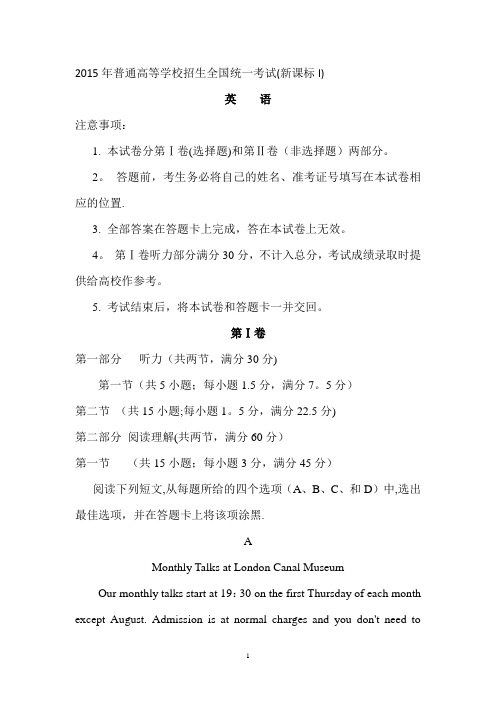
2015年普通高等学校招生全国统一考试(新课标I)英语注意事项:1. 本试卷分第Ⅰ卷(选择题)和第Ⅱ卷(非选择题)两部分。
2。
答题前,考生务必将自己的姓名、准考证号填写在本试卷相应的位置.3. 全部答案在答题卡上完成,答在本试卷上无效。
4。
第Ⅰ卷听力部分满分30分,不计入总分,考试成绩录取时提供给高校作参考。
5. 考试结束后,将本试卷和答题卡一并交回。
第Ⅰ卷第一部分听力(共两节,满分30分)第一节(共5小题;每小题1.5分,满分7。
5分)第二节(共15小题;每小题1。
5分,满分22.5分)第二部分阅读理解(共两节,满分60分)第一节(共15小题;每小题3分,满分45分)阅读下列短文,从每题所给的四个选项(A、B、C、和D)中,选出最佳选项,并在答题卡上将该项涂黑.AMonthly Talks at London Canal MuseumOur monthly talks start at 19:30 on the first Thursday of each month except August. Admission is at normal charges and you don't need tobook。
They end around 21:00。
November 7thThe Canal Pioneers,by Chris Lewis。
James Brindley is recognized as one of the leading early canal engineers. He was also a major player in training others in the art of canal planning and building. Chris Lewis will explain how Brindley made such a positive contribution to the education of that group of early “civil engine ers"。
2015年全国Ⅰ卷高考英语试题及答案

2015年全国Ⅰ卷高考英语试题及答案注意事项:1. 本试卷分第Ⅰ卷(选择题)和第Ⅱ卷(非选择题)两部分。
第Ⅰ卷1页至10页,第Ⅱ卷11页至13页。
2. 答题前,考生务必将自己的姓名,准考证号填写在本试卷相应的位置。
3. 全部答案在答题卡上完成,搭载本试卷上无效。
4. 第Ⅰ卷听力部分满分30分,不计入总分,考试成绩录取时提供给高校作参考。
5. 考试结束后,将本试卷和答题卡一并交回。
第Ⅰ卷第一部分听力(共两节,满分30分)(略)第二部分阅读理解(共两节,满分60分)第一节(共15小题;每小题3分,满分45分)阅读下列短文,从每题所给的四个选项(A、B、C、和D)中,选出最佳选项,并在答题卡上将该项涂黑。
AMonthly Talks at London Canal MuseumOur monthly talks start at 19:30 on the first Thursday of each month except August. Admission is at norma l charges and you don’t need to book. They end around 21:00.November 7thThe Canal Pioneers, by Chris Lewis. James Brindley is recognized as one of the leading early canal engineers. He was also a major player in training others in the art of nanal planning and building. Chris Lewis will explain how Brindley made such a positive contribution to the education of that group of early “civil enginerrs”.December 5thIce for the Metropolis, by Malcolm Tucker. Well before the arrival of freezers, there was a demand for ice for food preservation and catering, Malcolm will explain the history of importing natural ice and the technology of building ice wells, and how London’s ice trade grew. February 6thAn Update on the Cotsword Canals, by Liz Payne. The Smoudwater Canal is moving towardsreopenling. The Thames and Severn Canal will take a little longer. We will have a report on the present state of play.March 6thEyots and Aits- Thames Islands,by Mir anda Vickers. The Thames had many islands. Miranda has undertaken a review of all of them. She will tell us about those of greatest interest.Online bookings:/bookMore into:/whatsonLondon Canal Museum12-13 New Wharf Road, London NI 9RT www.canalmuseum.mobiTel************21.When is the talk on James Brindley?A. Feb ruary 6th.B. March 6th.[来源:学科网ZXXK][来源:学*科*网]C. November 7th.D. December 5th.【答案】C【解析】根据文章第二段第二句James Brindley is recognized as one of the leading early canal engineers.所对应的日期November 7th.故选C。
2015年高考英语全国卷1含答案
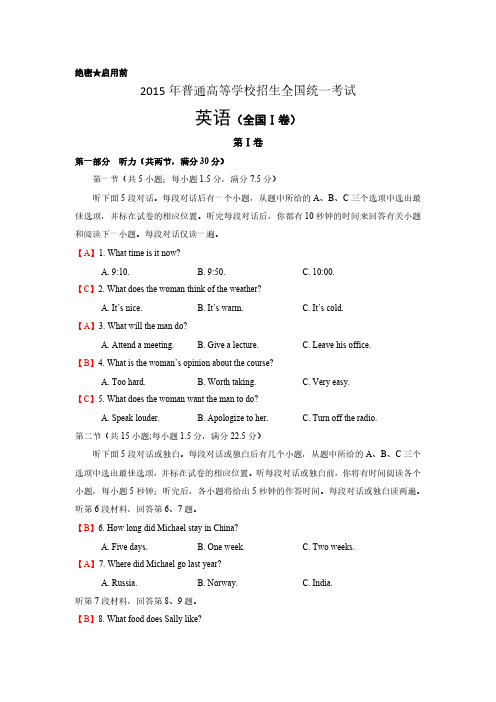
绝密★启用前2015年普通高等学校招生全国统一考试英语(全国Ⅰ卷)第Ⅰ卷第一部分听力(共两节,满分30分)第一节(共5小题;每小题1.5分,满分7.5分)听下面5段对话。
每段对话后有一个小题,从题中所给的A、B、C三个选项中选出最佳选项,并标在试卷的相应位置。
听完每段对话后,你都有10秒钟的时间来回答有关小题和阅读下一小题。
每段对话仅读一遍。
【A】1. What time is it now?A. 9:10.B. 9:50.C. 10:00.【C】2. What does the woman think of the weather?A. It’s nice.B. It’s warm.C. It’s cold.【A】3. What will the man do?A. Attend a meeting.B. Give a lecture.C. Leave his office.【B】4. What is the woman’s opinion about the course?A. Too hard.B. Worth taking.C. Very easy.【C】5. What does the woman want the man to do?A. Speak louder.B. Apologize to her.C. Turn off the radio.第二节(共15小题;每小题1.5分,满分22.5分)听下面5段对话或独白。
每段对话或独白后有几个小题,从题中所给的A、B、C三个选项中选出最佳选项,并标在试卷的相应位置。
听每段对话或独白前,你将有时间阅读各个小题,每小题5秒钟;听完后,各小题将给出5秒钟的作答时间。
每段对话或独白读两遍。
听第6段材料,回答第6、7题。
【B】6. How long did Michael stay in China?A. Five days.B. One week.C. Two weeks.【A】7. Where did Michael go last year?A. Russia.B. Norway.C. India.听第7段材料,回答第8、9题。
2015年高考英语全国1卷试题及答案
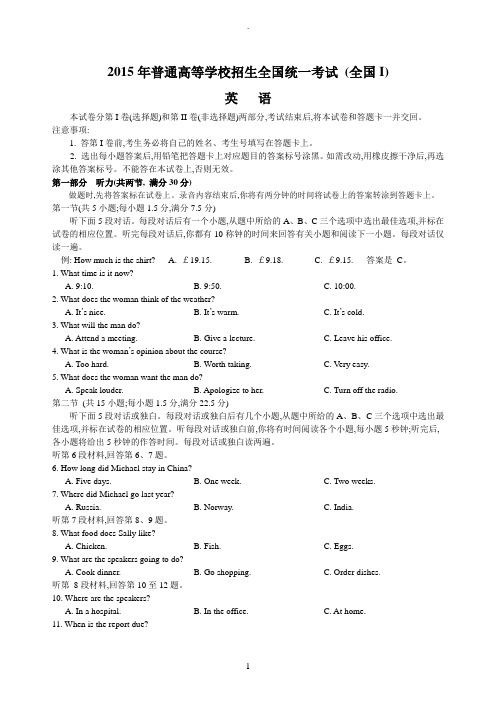
2015年普通高等学校招生全国统一考试(全国I)英语本试卷分第I卷(选择题)和第II卷(非选择题)两部分,考试结束后,将本试卷和答题卡一并交回。
注意事项:1. 答第I卷前,考生务必将自己的姓名、考生号填写在答题卡上。
2. 选出每小题答案后,用铅笔把答题卡上对应题目的答案标号涂黑。
如需改动,用橡皮擦干净后,再选涂其他答案标号。
不能答在本试卷上,否则无效。
第一部分听力(共两节, 满分30分)做题时,先将答案标在试卷上。
录音内容结束后,你将有两分钟的时间将试卷上的答案转涂到答题卡上。
第一节(共5小题;每小题1.5分,满分7.5分)听下面5段对话。
每段对话后有一个小题,从题中所给的A、B、C三个选项中选出最佳选项,并标在试卷的相应位置。
听完每段对话后,你都有10称钟的时间来回答有关小题和阅读下一小题。
每段对话仅读一遍。
例: How much is the shirt? A. £19.15. B. £9.18. C. £9.15. 答案是C。
1. What time is it now?A. 9:10.B. 9:50.C. 10:00.2. What does the woman think of the weather?A. It’s nice.B. It’s warm.C. It’s cold.3. What will the man do?A. Attend a meeting.B. Give a lecture.C. Leave his office.4. What is the woman’s opinion about the course?A. Too hard.B. Worth taking.C. Very easy.5. What does the woman want the man do?A. Speak louder.B. Apologize to her.C. Turn off the radio.第二节(共15小题;每小题1.5分,满分22.5分)听下面5段对话或独白。
2015年高考英语全国卷1及答案解析
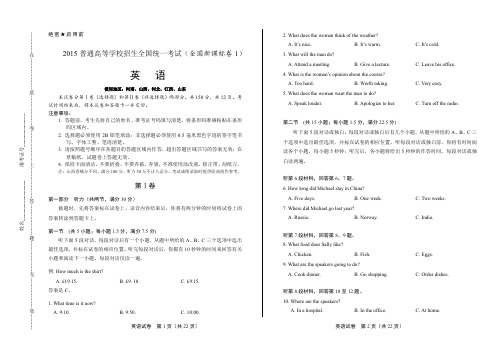
英语试卷 第1页(共22页)英语试卷 第2页(共22页)绝密★启用前2015普通高等学校招生全国统一考试(全国新课标卷1)英语使用地区:河南、山西、河北、江西、山东本试卷分第Ⅰ卷(选择题)和第Ⅱ卷(非选择题)两部分。
共150分,共12页。
考试时间结束后,将本试卷和答题卡一并交回。
注意事项:1. 答题前,考生先将自己的姓名、准考证号码填写清楚,将条形码准确粘贴在条形码区域内。
2. 选择题必须使用2B 铅笔填涂;非选择题必须使用0.5毫米黑色字迹的签字笔书写,字体工整、笔迹清楚。
3. 请按照题号顺序在各题目的答题区域内作答,超出答题区域书写的答案无效;在草稿纸、试题卷上答题无效。
4. 保持卡面清洁,不要折叠、不要弄破、弄皱,不准使用涂改液、修正带、刮纸刀。
注:山西卷赋分不同,满分180分。
听力30分不计入总分,考试成绩录取时提供给高校作参考。
第Ⅰ卷第一部分 听力(共两节,满分30分)做题时,先将答案标在试卷上。
录音内容结束后,你将有两分钟的时间将试卷上的答案转涂到答题卡上。
第一节 (共5小题;每小题1.5分,满分7.5分)听下面5段对话。
每段对话后有一个小题,从题中所给的A 、B 、C 三个选项中选出最佳选项,并标在试卷的相应位置。
听完每段对话后,你都有10秒钟的时间来回答有关小题和阅读下一小题。
每段对话仅读一遍。
例: How much is the shirt? A. £19.15.B. £9. 18.C. £9.15.答案是C 。
1. What time is it now? A. 9:10.B. 9:50.C. 10:00.2. What does the woman think of the weather? A. It’s nice.B. It’s warm.C. It’s cold.3. What will the man do? A. Attend a meeting.B. Give a lecture.C. Leave his office.4. What is the woman’s opinion about the course? A. Too hard.B. Worth taking.C. Very easy.5. What does the woman want the man to do? A. Speak louder.B. Apologize to her.C. Turn off the radio.第二节 (共15小题;每小题1.5分,满分22.5分)听下面5段对话或独白。
2015年高考英语全国1卷试题及答案 全国一卷试卷及答案
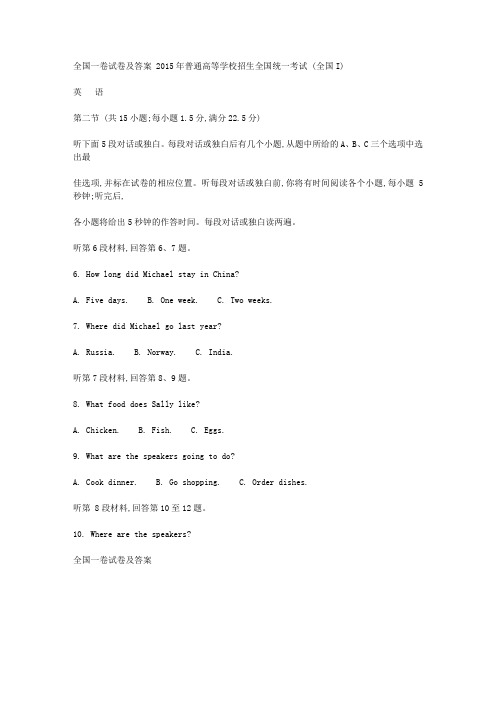
全国一卷试卷及答案 2015年普通高等学校招生全国统一考试 (全国I)
英语
第二节 (共15小题;每小题1.5分,满分22.5分)
听下面5段对话或独白。
每段对话或独白后有几个小题,从题中所给的A、B、C三个选项中选出最
佳选项,并标在试卷的相应位置。
听每段对话或独白前,你将有时间阅读各个小题,每小题5秒钟;听完后,
各小题将给出5秒钟的作答时间。
每段对话或独白读两遍。
听第6段材料,回答第6、7题。
6. How long did Michael stay in China?
A. Five days.
B. One week.
C. Two weeks.
7. Where did Michael go last year?
A. Russia.
B. Norway.
C. India.
听第7段材料,回答第8、9题。
8. What food does Sally like?
A. Chicken.
B. Fish.
C. Eggs.
9. What are the speakers going to do?
A. Cook dinner.
B. Go shopping.
C. Order dishes.
听第 8段材料,回答第10至12题。
10. Where are the speakers?
全国一卷试卷及答案。
2015年高考英语全国卷1-答案
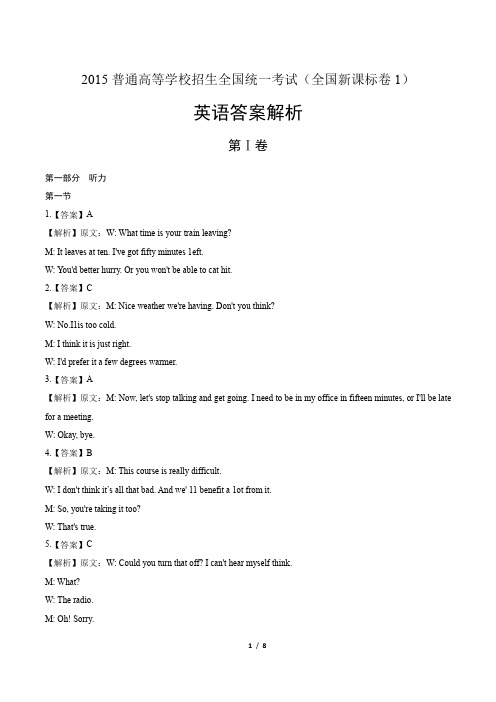
2015普通高等学校招生全国统一考试(全国新课标卷1)英语答案解析第Ⅰ卷第一部分听力第一节1.【答案】A【解析】原文:W: What time is your train leaving?M: It leaves at ten. I've got fifty minutes 1eft.W: You'd better hurry. Or you won't be able to cat hit.2.【答案】C【解析】原文:M: Nice weather we're having. Don't you think?W: No.I1is too cold.M: I think it is just right.W: I'd prefer it a few degrees warmer.3.【答案】A【解析】原文:M: Now, let's stop talking and get going. I need to be in my office in fifteen minutes, or I'll be late for a meeting.W: Okay, bye.4.【答案】B【解析】原文:M: This course is really difficult.W: I don't think it’s all that bad. And we' 11 benefit a 1ot from it.M: So, you're taking it too?W: That's true.5.【答案】C【解析】原文:W: Could you turn that off? I can't hear myself think.M: What?W: The radio.M: Oh! Sorry.第二节6.【答案】B7.【答案】A【解析】原文:W: Hi Michael! I heard you just came back from a holiday.M: Yes. I stayed for a week in China, and five days in India.W: You do travel a 1ot, don't you? Last year, you went to Norway, right?M: Well, I've been to quite some countries, but not yet to Norway Last summer. I toured Russia for two weeks.8.【答案】B9.【答案】C【解析】原文:M: Sally, do you like seafood?W: Yes, of course.M: Is there anything you especially like?W: Well, I really don't know. I can never remember the names.M: Olay. Is there any food you don't eat?W: Well, I don't eat chicken. And I don't like eggs, either. But I like all kinds of fish and vegetables.M: Then 1et's 1ook at the menu and see what they've got for us.10.【答案】B11.【答案】A12.【答案】B【解析】原文:M: You look pale, Stephanie. What's wrong?W: I don't feel good. I have a bad headache. In fact, I haven't got much sleep this past week, and I feel really tired. M: Why don't you go to see a doctor?W: Yeah, I think I should. But I have a report due tomorrow. Ms. Jenkins needs it for the board meeting next Monday.M: Well, it's Wednesday today. Why don't you talk to Ms. Jenkins, and ask if you can hand it in on Friday morning? W: Maybe I should try. I guess I just need a good sleep. Thanks, George.M: If you need any help with the report just let me know.13.【答案】C14.【答案】A15.【答案】B16.【答案】C【解析】原文:W: Anything interesting in the paper today, dear?M: Well, yeah. There are a few here that might interest us. Here's one for just four hundred dollars. It only has one bedroom. But it sounds nice near Lake Street.W: Yeah. Let me see what the cheapest two-bedroom apartment is. Oh, here's one on Market Street. It's a real bargain. Only three hundred and fifty dollars. But it doesn't have any furniture.M: Well, it costs a lot to buy all the furniture.W: Oh, here's another one for just over four hundred dollars. T his sounds very interesting! It’s on South Street. That's a nice area.M: Yes, it's quiet. Did you say two bedrooms?W: Yes, at four hundred and fifteen dollars.M: Why don't we go and have a 1ook?W: Okay, I'll give them a call.17.【答案】B18.【答案】A19.【答案】A20.【答案】C【解析】原文:Look at this picture. It's the London Tea Trade Centre. As you can see, it is on the north bank of the river Thames. It is the center of an important industry in the everyday lives of the British people. Tea is the British national drink. Every man, woman, and child over ten years of age has on average over four cups a day. Or someone thousand, five hundred cups annually. About thirty percent of the world's exports of tea makes its way to London. And Britain is by far the largest importer of tea in the world. Now, in the second picture, you can see how tea is tasted in the Tea Trade Centre before it is sold. Here, different types of tea are tasted by skilled tea tasters. Before they're sold at each week's tea sale. It' s amazing to see them at work. Over a hundred kinds of tea are laid out in a line on 1ong tables. The tasters generally taste teas with milk, since that is how the majority of British people drink their tea. The tasters move down the line with surprising speed, tasting from a spoon and deciding what is a fair price for each tea. After that, they...第二部分阅读理解第一节21.【答案】C【解析】根据文章第二段第二句James Brindley is recognized as one of the leading early canal engineers.所对应的日期November 7th。
2015年全国1卷高考英语试题附答案

2015年高考全国1卷英语试题及答案第二部分阅读理解(共两节,满分60分)第一节(共15小题;每小题3分,满分45分)阅读下列短文,从每题所给的四个选项(A、B、C、和D)中,选出最佳选项,并在答题卡上将该项涂黑。
AMonthly T alks at London Canal MuseumOur monthly talks start at 19:30 on the first Thursday of each month except August. Admission is at normal charges and you don’t need to book. They end around 21:00. November 7thThe Canal Pioneers, by Chris Lewis. James Brindley is recognized as one of the leading early canal engineers. He was also a major player in training others in the art of canal planning and building. Chris Lewis will explain how Brindley made such a positive contribution to the education of that group of early “civil engineers”.December 5thIce for the Metropolis, by Malcolm Tucker. Well before the arrival of freezers, there was a demand for ice for food preservation and catering, Malcolm will explain the history of importing natural ice and the technology of building ice wells, and how London’s ice trade grew. February 6thAn Update on the Cotswold Canals, by Liz Payne. The Stroudwater Canal is moving towards reopening. The Thames and Severn Canal will take a little longer. We will have a report on the present state of play.March 6thEyots and Aits-Thames Islands,by Miranda Vickers. The Thames had many islands. Miranda has undertaken a review of all of them. She will tell us about those of greatest interest.Online bookings:/bookMore info:/whatsonLondon Canal Museum12-13 New Wharf Road, London NI 9RT www.canalmuseum.mobiTel************21.When is the talk on James Brindley?A. November 7th.B. March 6th.C. February 6th.D. December 5th.22. What is the topic of the talk in February?A. The Canal Pioneers.B. Ice for the MetropolisC. Eyots and Aits- Thames IslandsD. An Update on the Cotswold Canals23. Who will give the talk on the islands in the Thames?A. Chris LewisB. Malcolm TuckerC. Miranda VickersD. Liz PayneBThe freezing Northeast hasn’t been a terribly fun place to spend time this winter, so when the chance came for a weekend to Sarasota, Florida, my bags were packed before you could say “sunshine”. I left for the land of warmth and vitamin C(维生素C), thinking of beaches and orange trees. When we touched down to blue skies and warm air, I sent up a small prayer of gratefulness. Swimming pools, wine tasting, and pink sunsets(at normal evening hours, not 4 in the afternoon) filled the weekend, but the best part-particularly to my taste, dulled by months of cold-weather root vegetables-was a 7 a.m. adventure to the Sarasota farmers’market that proved to be more than worth the early wake-up call.The market, which was founded in 1979, sets up its tents every Saturday from 7 am to 1 p.m, rain or shine, along North Lemon and State streets. Baskets of perfect red strawberries, the red-painted sides of the Java Dawg coffee truck; and most of all, the tomatoes: amazing, large, soft and round red tomatoes.Disappointed by many a broken, vine-ripened(蔓上成熟的) promise, I’ve refused to buywinter tomatoes for years. No matter how attractive they look in the store, once I get them home they’re unfailingly dry, hard, and tasteless. But I homed in, with uncertainty, on one particular table at the Brown’s Grove Farm’s stand, full of fresh and soft tomatoes the size of my fist. These were the real deal- and at that moment, I realized that the best part of Sarasota in winter was going to be eating things that back home in New York I wouldn’t be experiencing again for months.Delighted as I was by the tomatoes in sight, my happiness deepened when I learned that Brown’s Grove Farm is one of the suppliers for Jack Dusty, a newly opened restaurant at the Sarasota Ritz Carlton, where-luckily for me-I was planning to have dinner that very night. Without even seeing the menu, I knew I’d be ordering every tomato on it.24. What did the author think of her winter life in New York?A. Exciting.B. Boring.C. Relaxing.D. Annoying.25. What made the author’s getting up early worthwhile?A. Having a swim.B. Breathing in fresh air.C. Walking in the morning sun.D. Visiting a local farmer’s market.26. What can we learn about tomatoes sold in New York in winter?A. They are soft.B. They look nice.C. They taste great.D. They are juicy.27. What was the author going to do that evening?A. Eat in a restaurant.B. Check into a hotel.C. Go to a farm.D. Buy fresh vegetables.CSalvador Dali (1904-1989) was one of the most popular of modern artists. The PompidouCentre in Paris is showing its respect and admiration for the artist and his powerful personality with an exhibition bringing together over 200 paintings, sculptures, drawings and more. Among the works and masterworks on exhibition the visitor will find the best pieces, most importantly The Persistence of Memory. There is also L’Enigme sans Fin from 1938, works on paper, objects, and projects for stage and screen and selected parts from television programmes reflecting the artist’s showman qualities.The visitor will enter the World of Dali through an egg and is met with the beginning, the world of birth. The exhibition follows a path of time and subject with the visitor exiting through the brain.The exhibition shows how Dali draws the viewer between two infinities (无限). “From the infinity small to the infinity large, contraction and expansion coming in and out of focus: amazing Flemish accuracy and the showy Baroque of old painting that he used in his museum-theatre in Figueras,”explains the Pompidou Centre.The fine selection of the major works was done in close collaboration (合作)with the Museo Nacional Reina Sofia in Madrid, Spain, and with contributions from other institutions like theSalvador Dali Museum in St. Petersburg, Florida.28. Which of the following best describes Dali according to Paragraph 1?A. Optimistic.B. ProductiveC. Generous.D. Traditional.29. What is Dali’s The Persistence of Memory considered to be?A. One of his masterworks.B. A successful screen adaptation.C. An artistic creation for the stage.D. One of the beat TV programmes.30. How are the exhibits arranged at the World of Dali?A. By popularity.B. By importance.C. By size and shape.D. By time and subject.31. What does the word “contributions”in the last paragraph refer to?A. Donations.B. Projects.C. Artworks.D. Documents.DConflict is on the menu tonight at the caféLa Chope. This evening, as on every Thursday night, psychologist Maud Lehanne is leading two of France’s favorite pastimes, coffee drinking and the “talking cure”. Here they are learning to get in touch with their true feelings. It isn’t always easy. The customers-some thirty Parisians who pay just under $2 (plus drinks) per session-are quick to intellectualize (高谈阔论),slow to open up and connect. “You are forbidden to say ‘one feels,’or ‘people think’,”Lehanne told them. “Say ‘I think,’‘Think me’.”A cafe society where no intellectualizing is allowed? It couldn’t seem more un-French. But Lehanne’s psychology cafe is about more than knowing oneself: It’s trying to help the city’s troubled neighborhood cafes. Over the years, Parisian cafes have fallen victim to changes in the French lifestyle-longer working hours, a fast-food boom and a younger generation’s desire to spend more time at home. Dozens of new theme cafes appear to change the situation. Cafes focused around psychology, history, and engineering are catching on, filling tables well into the evening.The city’s “psychology cafes”, which offer great comfort, are among the most popular places. Middle-aged homemakers, retirees, and the unemployed come to such cafes to talk about love, anger, and dreams with a psychologist. And they come to Lehanne’s group just to learn to say what they feel. “There’s a strong need in Paris for communication,”says Maurice Frisch, a cafe La Chope regular who works as a religious instructor in a nearby church. “People have few real friends.And they need to open up.”Lehanne says she’d like to see psychology cafes all over France. “If people had normal lives, these cafes wouldn’t exist,”she says. “If life weren’t a battle, people wouldn’t need a special place just to speak.”But then, it wouldn’t be France.32.What are people encouraged to do at the cafe La Chope?A. Learn a new subjectB. Keep in touch with friends.C. Show off their knowledge.D. Express their true feelings.33. How are cafes affected by French lifestyle changes?A. They have bigger night crowds.B. They stay open for longer hours.C. They are less frequently visited.D. They start to serve fast food.34. What are theme cafes expected to do?A. Save the cafe business.B. Supply better drinks.C. Create more jobs.D. Serve the neighborhood.35. Why are psychology cafes becoming popular in Paris?A. They bring people true friendship.B. They give people spiritual support.C. They help people realize their dreams.D. They offer a platform for business links.第二节(共5小题,每小题3分,满分15分)根据短文内容,从短文后的选项中选出能填入空白处的最佳选项,选项中有两项为多余选项。
2015年高考英语全国卷1含答案

绝密★启用前2015年普通高等学校招生全国统一考试英语(全国Ⅰ卷)第Ⅰ卷第一部分听力(共两节,满分30分)第一节(共5小题;每小题1.5分,满分7.5分)听下面5段对话。
每段对话后有一个小题,从题中所给的A、B、C三个选项中选出最佳选项,并标在试卷的相应位置。
听完每段对话后,你都有10秒钟的时间来回答有关小题和阅读下一小题。
每段对话仅读一遍。
【A】1. What time is it now?A. 9:10.B. 9:50.C. 10:00.【C】2. What does the woman think of the weather?A. It’s nice.B. It’s warm.C. It’s cold.【A】3. What will the man do?A. Attend a meeting.B. Give a lecture.C. Leave his office.【B】4. What is the woman’s opinion about the course?A. Too hard.B. Worth taking.C. Very easy.【C】5. What does the woman want the man to do?A. Speak louder.B. Apologize to her.C. Turn off the radio.第二节(共15小题;每小题1.5分,满分22.5分)听下面5段对话或独白。
每段对话或独白后有几个小题,从题中所给的A、B、C三个选项中选出最佳选项,并标在试卷的相应位置。
听每段对话或独白前,你将有时间阅读各个小题,每小题5秒钟;听完后,各小题将给出5秒钟的作答时间。
每段对话或独白读两遍。
听第6段材料,回答第6、7题。
【B】6. How long did Michael stay in China?A. Five days.B. One week.C. Two weeks.【A】7. Where did Michael go last year?A. Russia.B. Norway.C. India.听第7段材料,回答第8、9题。
2015年高考英语全国卷1及标准答案
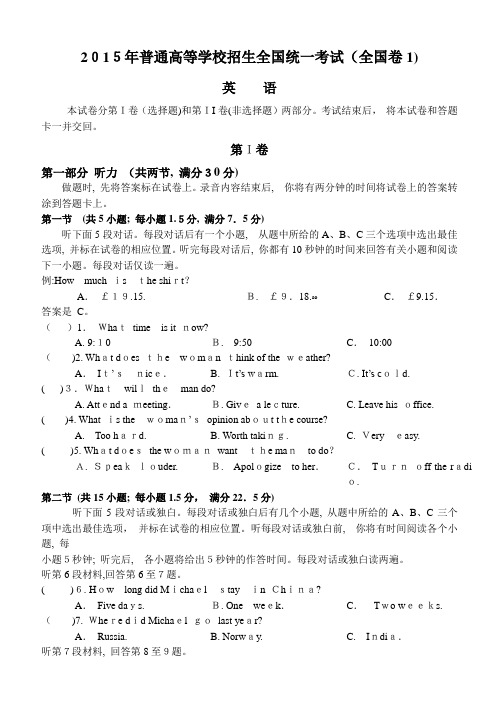
2015年普通高等学校招生全国统一考试(全国卷1)英语本试卷分第I卷(选择题)和第II卷(非选择题)两部分。
考试结束后,将本试卷和答题卡一并交回。
第I卷第一部分听力(共两节, 满分30分)做题时, 先将答案标在试卷上。
录音内容结束后,你将有两分钟的时间将试卷上的答案转涂到答题卡上。
第一节(共5小题; 每小题1.5分, 满分7.5分)听下面5段对话。
每段对话后有一个小题,从题中所给的A、B、C三个选项中选出最佳选项, 并标在试卷的相应位置。
听完每段对话后, 你都有10秒钟的时间来回答有关小题和阅读下一小题。
每段对话仅读一遍。
例:How much isthe shirt?A.£19.15. B.£9.18.ﻩﻩC.£9.15.答案是C。
()1.Whattime is it now?A. 9:10 B.9:50 C.10:00()2. What does the woman think of the weather?A.It’snice. B. It’s warm. C. It’s cold.( )3.Whatwilltheman do?A. Attend a meeting.B. Givea lecture. C. Leave his office.( )4. What is thewoman’sopinion about the course?A.Too hard.B. Worth taking.C. Veryeasy.()5. What doesthe womanwantthe manto do?A. Speaklouder. B.Apologize to her.C.Turnoff the radio.第二节(共15小题; 每小题1.5分,满分22.5分)听下面5段对话或独白。
每段对话或独白后有几个小题, 从题中所给的A、B、C三个项中选出最佳选项,并标在试卷的相应位置。
听每段对话或独白前,你将有时间阅读各个小题, 每小题5秒钟; 听完后,各小题将给出5秒钟的作答时间。
2015全国高考卷1(含答案解析)
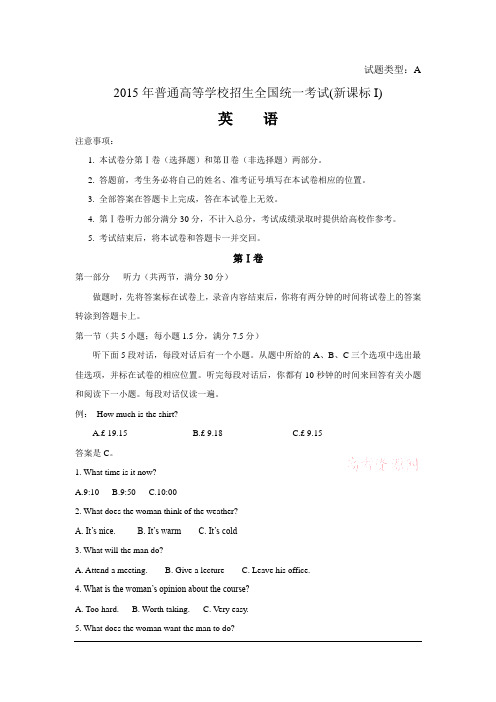
试题类型:A 2015年普通高等学校招生全国统一考试(新课标I)英语注意事项:1. 本试卷分第Ⅰ卷(选择题)和第Ⅱ卷(非选择题)两部分。
2. 答题前,考生务必将自己的姓名、准考证号填写在本试卷相应的位置。
3. 全部答案在答题卡上完成,答在本试卷上无效。
4. 第Ⅰ卷听力部分满分30分,不计入总分,考试成绩录取时提供给高校作参考。
5. 考试结束后,将本试卷和答题卡一并交回。
第Ⅰ卷第一部分听力(共两节,满分30分)做题时,先将答案标在试卷上,录音内容结束后,你将有两分钟的时间将试卷上的答案转涂到答题卡上。
第一节(共5小题;每小题1.5分,满分7.5分)听下面5段对话,每段对话后有一个小题。
从题中所给的A、B、C三个选项中选出最佳选项,并标在试卷的相应位置。
听完每段对话后,你都有10秒钟的时间来回答有关小题和阅读下一小题。
每段对话仅读一遍。
例:How much is the shirt?A.£ 19.15B.£ 9.18C.£ 9.15答案是C。
1. What time is it now?A.9:10B.9:50C.10:002. What does the woman think of the weather?A. It‟s nice.B. It‟s warmC. It‟s cold3. What will the man do?A. Attend a meeting.B. Give a lectureC. Leave his office.4. What is the woman‟s opinion about the course?A. Too hard.B. Worth taking.C. Very easy.5. What does the woman want the man to do?A. Speak louder.B. Apologize to her.C. Turn off the radio.第二节(共15小题;每小题1.5分,满分22.5分)听下面5段对话或独白。
2015年高考全国卷1英语试题及答案解析(word精校版)

2015年高考全国卷1英语试题及答案解析(word精校版)注意事项:1. 本试卷分第Ⅰ卷(选择题)和第Ⅱ卷(非选择题)两部分。
第Ⅰ卷1页至10页,第Ⅱ卷11页至13页。
2. 答题前,考生务必将自己的姓名,准考证号填写在本试卷相应的位置。
3. 全部答案在答题卡上完成,搭载本试卷上无效。
4. 第Ⅰ卷听力部分满分30分,不计入总分,考试成绩录取时提供给高校作参考。
5. 考试结束后,将本试卷和答题卡一并交回。
第Ⅰ卷第一部分听力(共两节,满分30分)做题时,现将答案标在试卷上,录音内容结束后,你将有两分钟的时间将试卷上的答案转涂到答题卡上。
第一节(共5小题;每小题1.5分,满分7.5分)(略)听下面5段对话,每段对话后有一个小题。
从题中所给的A,B,C三个选项中选出最佳选项,并标在试卷的相应位置。
听完每段对话后,你都有10秒钟的时间来回答有关小题和阅读下一小题。
每段对话仅读一遍。
例: How much is the shirt?A.£ 19.15B.£ 9.18C.£ 9.15答案是C。
第二部分阅读理解(共两节,满分60分)第一节(共15小题;每小题3分,满分45分)阅读下列短文,从每题所给的四个选项(A、B、C、和D)中,选出最佳选项,并在答题卡上将该项涂黑。
AMonthly Talks at London Canal MuseumOur monthly talks start at 19:30 on the first Thursday of each month except August. Admission i s at normal charges and you don’t need to book. They end around 21:00.November 7thThe Canal Pioneers, by Chris Lewis. James Brindley is recognized as one of the leading early canal engineers. He was also a major player in training others in the art of nanal planning and building. Chris Lewis will explain how Brindley made such a positive contribution to the education of that group of early “civil enginerrs”.December 5thIce for the Metropolis, by Malcolm Tucker. Well before the arrival of freezers, there was a demand for ice for food preservation and catering, Malcolm will explain the history of importing natural ice and the technology of building ice wells, and how London’s ice trade grew.February 6thAn Update on the Cotsword Canals, by Liz Payne. The Smoudwater Canal is moving towards reopenling. The Thames and Severn Canal will take a little longer. We will have a report on the present state of play.March 6thEyots and Aits- Thames Islands,by Miranda Vickers. The Thames had many islands. Miranda has undertaken a review of all of them. She will tell us about those of greatest interest.Online bookings:More into:London Canal Museum12-13 New Wharf Road, London NI 9RTTel:21.When is the talk on James Brindley?A. February 6th.B. March 6th.C. November 7th.D. December 5th.22. What is the topic of the talk in February?A. The Canal Pioneers.B. Ice for the MetropolisC. Eyots and Aits- Thames IslandsD. An Update on the Cotsword Canals23. Who will give the talk on the islands in the Thames.A. Miranda VickersB. Malcolm TuckerC. Chris LewisD. Liz PayneBThe freezing Northeast hasn’t been a terribly fun place t o spend time this winter, so when the chance came for a weekend to Sarasota, Florida, my bags were packed before you could say “sunshine”. I left for the land of warmth and vitamin C(维生素C), thinking of beaches and orange trees. When we touched down to blue skies and warm air, I sent up a small prayer of gratefulness. Swimming pools, wine tasting, and pink sunsets(at normal evening hours, not 4 in the afternoon) filled the weekend, but the best part- particularly to my taste, dulled by months of cold- weather root vegetables- was a 7 a.m. adventure to the Sarasota farmers’ market that proved to be more than worth the early wake-up call.The market, which was founded in 1979, sets up its tents every Saturday from 7:00 am to 1 p.m, rain or shine, along North Lemon and State streets. Baskets of perfect red strawberries, the red-painted sides of the Java Dawg coffee truck; and most of all, the tomatoes: amazing, large, soft and round red tomatoes.Disappointed by many a broken, vine-ripened(蔓上成熟的) promise, I’ve r efused to buy winter tomatoes for years. No matter how attractive they look in the store, once I get them home they’re unfailingly dry, hard, and tasteless. But I homed in, with uncertainty, on one particular table at the Brown’s Grove Farm’s stand, full o f fresh and soft tomatoes the size of my fist. These were the real deal- and at that moment, I realized that the best part of Sarasota in winter was going to be eating things that back home in New York I wouldn’t be experiencing again for months.Delighted as I was by the tomatoes in sight, my happiness deepened when I learned that Brown’s Grove Farm is one of the suppliers for Jack Dusty, a newly opened restaurant at the Sarasota Ritz Carlton, where- luckily for me- I was planning to have dinner that very night. Without even seeing the menu, I knew I’d be ordering every tomato on it.24. What did the author think of her winter life in New York?A. Exciting.B. Boring.C. Relaxing.D. Annoying.25. What made the author’s getting up late early worthwh ile?A. Having a swim.B. Breathing in fresh air.C. Walking in the morning sun.D. Visiting a local farmer’s market.26. What can we learn about tomatoes sold in New York in winter?A. They are soft.B. They look nice.C. They taste great.D. They are juicy.27. What was the author going to that evening?A. Go to a farm.B. Check into a hotel.C. Eat in a restaurant.D. Buy fresh vegatables.CSalvador Dali (1904-1989) was one of the most popular of modern artists. The Pompidou Centre in Paris is showing its respect and admiration for the artist and his powerful personality with an exhibition bringing together over 200 paintings, sculptures, drawings and more. Amongthe works and masterworks on exhibition the visitor will find the best pieces, most importantly The Persistence of Memory. There is also L’Enigme sans Fin from 1938, works on paper, objects, and projects for stage and screen and selected parts from television programmes reflecting the artist’s showman qualities.The visitor will enter the World of Dali through an egg and is met with the beginning, the world of birth. The exhibition follows a path of time and subject with the visitor exiting through the brain.The exhibition shows how Dali draws the viewer between two infinities (无限). “From the infinity small to the infinity large, contraction and expansion coming in and out of focus: amazing Flemish accuracy and the showy Baroque of old painting that he used in his museum-theatre in Figueras,” explains the Pompidou Centre.The fine selection of the major works was done in close collaboration (合作)with the Museo Nacional Reina Sofia in Madrid, Spain, and with contributions from other institutions like the Salvador Dali Museum in St. Petersburg.28. Which of the following best describe Dali according to Paragraph 1?A. Optimistic.B. ProductiveC. Generous.D. Traditional.29. What is Dali’s The Persistence of Memory considered to be?A. One of his masterworks.B. A successful screen adaptation.C. An artistic creation for the stage.D. One of the beat TV programmes.30. How are the exhibits arranged at the World of Dali?A. By popularity.B. By importance.C. By size and shape.D. By time and subject.31. What does the word “contributions” in the last paragraph refer to?A. Artworks.B. Projects.C. Donations.D. Documents.DConflict is on the menu tonight at the café La Chope. This evening, as on every Thursday night, psychologist Maud Lehanne is leading two of France’s favorite pastimes, coffee dr inking and the “talking cure”. Here they are learning to get in touch with their true feelings. It isn’t always easy. They customers-some thirty Parisians who pay just under $2 (plus drinks) per session-care quick to intellectualize (高谈阔论),slow to open up and connect. “You are forbidden to say ‘one feels,’ or ‘people think’,”Lehane told them. “Say ‘I think,’ ‘Think me’.”A café society where no intellectualizing is allowed? It couldn’t seem more un-French. But Lehanne’s psychology café is about more than knowing oneself: It’s trying to help the city’s troubled neighborhood cafes. Over the years, Parisian cafes have fallen victim to changes in the French lifestyle-longer working hours, a fast food boom and a younger generation’s desire to spend more time at home. Dozens of new theme cafes appear to change the situation. Cafes focused around psychology, history, and engineering are catching on, filling tables well into the evening.32.What are people encouraged to do at the cafe La Chope?A. Learn a new subjectB. Keep in touch with friends.C. Show off their knowledge.D. Express their true feelings.33. How are cafes affected by French lifestyle changes?A. They are less frequently visited.B. They stay open for longer hours.C. They have bigger night crowds.D. They start to serve fast food.34. What are theme cafes expected to do?A. Create more jobs.B. Supply better drinks.C. Save the cafe business.D. Serve the neighborhood.35. Why are psychology cafes becoming popular in Paris?A. They bring people true friendship.B. They give people spiritual support.C. They help people realize their dreams.D. They offer a platform for business links.D篇.文章大意:文章主要讲述了精神咖啡馆在法国越来越受欢迎。
2015年英语高考全国卷真题及答案

英语本试卷分第I卷(选择题)和第II卷(非选择题)两部分,考试结束后,将本试卷和答题卡一并交回。
注意事项:1. 答第I卷前,考生务必将自己的姓名、考生号填写在答题卡上。
2. 选出每小题答案后,用铅笔把答题卡上对应题目的答案标号涂黑。
如需改动,用橡皮擦干净后,再选涂其他答案标号。
不能答在本试卷上,否则无效。
第一部分听力(共两节, 满分30分)做题时,先将答案标在试卷上。
录音内容结束后,你将有两分钟的时间将试卷上的答案转涂到答题卡上。
第一节(共5小题;每小题1.5分,满分7.5分)听下面5段对话。
每段对话后有一个小题,从题中所给的A、B、C三个选项中选出最佳选项,并标在试卷的相应位置。
听完每段对话后,你都有10称钟的时间来回答有关小题和阅读下一小题。
每段对话仅读一遍。
例: How much is the shirt? A. £19.15. B. £9.18. C. £9.15. 答案是C。
1. What time is it now?A. 9:10.B. 9:50.C. 10:00.2. What does the woman think of the weather?A. It’s nice.B. It’s warm.C. It’s cold.3. What will the man do?A. Attend a meeting.B. Give a lecture.C. Leave his office.4. What is the woman’s opinion about the course?A. Too hard.B. Worth taking.C. Very easy.5. What does the woman want the man do?A. Speak louder.B. Apologize to her.C. Turn off the radio.第二节(共15小题;每小题1.5分,满分22.5分)听下面5段对话或独白。
15年高考英语真题全国卷一及答案
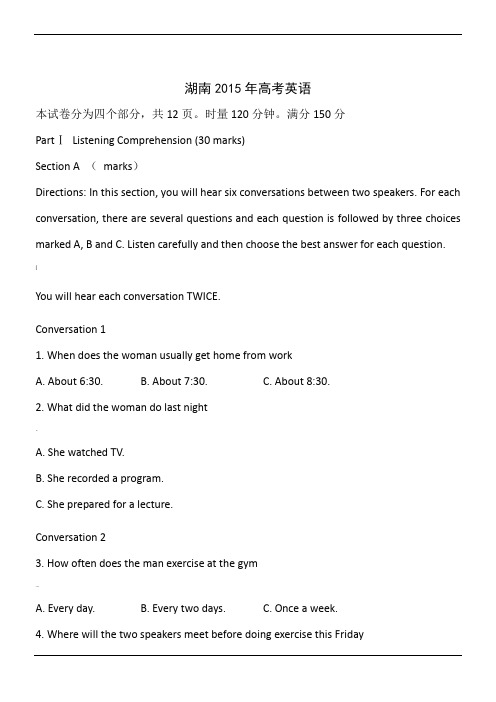
湖南2015年高考英语本试卷分为四个部分,共12页。
时量120分钟。
满分150分PartⅠListening Comprehension (30 marks)Section A (marks)Directions: In this section, you will hear six conversations between two speakers. For each conversation, there are several questions and each question is followed by three choices marked A, B and C. Listen carefully and then choose the best answer for each question.[You will hear each conversation TWICE.Conversation 11. When does the woman usually get home from workA. About 6:30.B. About 7:30.C. About 8:30.2. What did the woman do last night、A. She watched TV.B. She recorded a program.C. She prepared for a lecture.Conversation 23. How often does the man exercise at the gym…A. Every day.B. Every two days.C. Once a week.4. Where will the two speakers meet before doing exercise this FridayA. At the park.B. At the cafe.C. At the cinema. Conversation 35. What is Mr. Chester doing>A. Telephoning someone.B. Speaking to the woman.C. Leaving the man a message.6. What is the man's last nameA. Oliver.B. Horst.C. Robert.@Conversation 47. Why will the woman be lateA. She didn't catch the train.B. She didn't finish her paper.C. She didn't wake up in time.|8. Where is the manA. At the station.B. At home.C. At the office.9. What is the probable relationship between the two speakersA. Teacher and student.B. Parent and child.`C. Husband and wife.Conversation 510. For whom does the woman buy the T-shirtA. Herself.B. Her husband.C. Her friend.11. How much does the T-shirt normally cost;A. $54.B. $60.C. $70.12. Why does the salesman agree to sell the T-shirt at $48A. It is cheaper online.B. He is in a hurry.C. A button is lost.*Conversation 613. When did the woman arriveA. Friday.B. Saturday.C. Sunday.14. What major did the man choose in the endA. English.B. Biology.C. History.$15. What suggestion does the man give on reading the booksA. Making notes.B. Skimming first.C. Reading word by word. Section B(marks)Directions: In this section, you will hear a short passage. Listen carefully and then fill in the numbered blanks with the information you have heard. Fill in each blank with NO MORE THAN THREE WORDS.You will hear the short passage TWICEPart ⅡLanguage Knowledge (45 marks)!Section A (15 marks)Directions: For each of the following unfinished sentences there are four choices marked A, B, C and D. Choose the one that best completes the sentence.was when we were returning home ________ I realized what a good feeling it was to have helped someone in trouble.A. whichB. thatC. whereD. how22. As you go through this book, you ________ that each of the millions of people who lived through World War II had a different experience.@A. will findB. foundC. had foundD. have found23. Only after talking to two students ________ that having strong motivation is one of the biggest factors in reaching goals.A. I did discoverB. did I discoverC. I discoveredD. discovered24. Video games can be a poor influence if ________ in the wrong hands.A. to leaveB. leavingC. leaveD. left'25. I wasn't able to hide my eagerness when I ________, "What do you wish me to do now"A. askB. have askedC. am askingD. asked26. You have to know ________ you're going if you are to plan the best way of getting there.A. whatB. thatC. whereD. who27. It is important to remember that success ________ a sum of small efforts made each day and often ________ years of achieve.…A. is; takesB. are; takesC. are; takeD. is; take28. He must have sensed that I ________ him. He suddenly glanced at me and said quietly,"Why are you staring at me like that"A. would look atB. looked atC. was looking atD. am looking at29. It is a truly delightful place, ________ looks the same as it must have done 100 years ago with its winding streets and pretty cottages..】A. asB. whereC. thatD. which30. ________ what you’re doing today important, because you’re trading a day of your life for itA. MakeB. To makeC. MakingD. Madeam looking forward to the day ________ my daughter can read this book and know my feelings for her.A. asB. whyC. whenD. where/32. All we need ________ a small piece of land where we can plant various kinds of fruit trees throughout the growing seasons of the year.A. areB. wasC. isD. were33. It’s not doing the things we like, but liking the th ings we have to do ________ makes life happy.A. thatB. whichC. whatD. who34. Whenever you ________ a present, you should think about it from the receiver’s point of view.$A. boughtB. have boughtC. will buyD. buy35. ________ ourselves from the physical and mental tensions, we each need deep thought and inner quietness.A. Having freedB. FreedC. To free:D. FreeingSection B (18 marks)Directions: For each blank in the following passage there are four words or phrases marked A, B, C and D. Fill in each blank with the word or phrase that best fits the context.It was a rainy morning and the children, mainly boys with various learning difficulties, refused to settle for the start of the lesson. As an inexperienced teacher, I tried every means to get them to be 36 , but in vain. my panic was rising and I could feel my heart beating wildly. This was the 37 of my job as a music teacher, I thought -- teaching was not for me. Then I had an idea. Hoping that no one would notice that I was 38 inside, I threw my voice as far as it would reach: "Put your heads on the desks and close your 39 ! We are going on a journey."40 , the children fell silent. "Now what should I do" I thought to myself. Reaching over to my collection of CDs, I blindly 41 , put it in the machine and played it.;Obediently (顺从地), my class lay their heads on their desk, closed their eyes and 42 . When the music started, the room as filled with the most beautiful tones and musical colors I could have ever imagined. All the children were 43 . When the music finished, I asked them all to raise their 44 slowly so that we could share our musical journey.At this point, when all the children were willing to share their experiences, I began to learn how to 45 . The music allow me to learn that teaching is about sharing and respect, tears and smiles, the knowing and the46 and most of all, an understanding of each other. This was the power that47 in the classroom could have.36. A. glad B. safe C. kind D. quiet. end B. aim C. rule D. plan38. A. guessing B. shaking C. responding D. laughing》39. A. eyes B. mouths C. books D. doors40. A. Punctually B. Importantly C. Amazingly D. Obviously41. A. passed one on B. gave one back C. turned one in D. took one out42. A. slept B. nodded C. waited D. continued43. A. talking B. singing C. dancing D. listening.44. A. legs B. heads C. arms D. shoulders45. A. teach B. imagine C. play D. understand46. A. unprepared B. unspoken C. unknown D. unforgotten47. A. games B. music C. tears D. knowledge Section C (12 marks)·Directions: Complete the following passage by filling in each blank with one word that best fits the context.Research has become both simpler and more complex. It's simpler because, 48 you have computer, you can find information you need by searching the Internet. For all you information, you don't have to go to 49 library to find the relevant resource and take notes on it. Instead, you can find some sources from the Internet50 print the copies needed. Remember, however, that you should usually consult different types of sources. That is, you 51 always rely just on the Internet for you research.While finding information is easier than ever, at the same time, researching has become 52 complex. There is a lot more material available, which means you may be overwhelmed 53 the amount of information. You need to learn 54 to sort through and find the relevant information for your particular project. Also, 55 need to check the accuracy of it.Part ⅢReading Comprehension (30 marks)】Directions: Read the following three passages. Each passage is followed by several questions or unfinished .statements For each of them there are four chokes marked A. B.C and D. Choose the one that fits best according to the information given in the passage.A"56. Michael Horan wrote the letter mainly to show that _______.A. drivers should be polite to cyclistsB. road accidents can actually be avoidedC. sine pedestrians are a threat to road safetyD. walking while using phones hurts one's eyes@57. Carol Harvey suggests that cyclists should _______.A. be provided with enough roadsB. be asked to ride on their own lanesC. be made to pay less tax for cyclingD. be fined for laughing at policemen#58. What is a complaint of JMLA. Very few drivers are insured.B. Cyclists ride fast on pavements.C. Pedestrians go through red traffic lights.D. Horse riders disrespect other road users.<59. The underlined word "they" in the third letter refers to ______.A. accidentsB. vehiclesC. pedestriansD. cyclists60. The three letters present viewpoints on _______.A. real source of road danger【B. ways to improve road facilitiesC. measures to punish road offencesD. increased awareness of road rulesBIn its early history, Chicago had floods frequently, especially in the spring, making the streets so muddy that people, horses, and carts got stuck. An old joke that was popular at the time went something like this: A man is stuck up to his waist in a muddy Chicago street. Asked if he needs help, he replies, "No, thanks. I've got a good horse under me."~The city planner decided to build an underground drainage (排水) system, but there simply wasn't enough difference between the height of the ground level and the water level. The only two options were to lower the Chicago River or raise the city.An engineer named Ellis Chesbrough convinced me the city that it had no choice but to build the pipes above ground and then cover them with dirt. This raised the level of the city's streets by as much as 12 feet.This of course created a new problem: dirt practically buried the first floors of every building in Chicago. Building owners were faced with a choice: either change the first floors of their buildings into basements, and the second stories into main floors, or hoist the entire buildings to meet the new street level. Small wood-frame buildings could be lifted fairly easily. But what about large, heavy structures like Tremont Hotel, which was asix-story brick buildingThat's where George Pullman came in. He had developed some house-moving skills successfully. To lift a big structure like the Tremont Hotel, Pullman would place thousands of jackscrews (螺旋千斤顶) beneath the building's foundation. One man was assigned to operate each section of roughly 10 jackscrews. At Pullman's signal each man turned his jackscrew the same amount at the same time, thereby raising the building slowly and evenly. Astonishingly, the Tremont Hotel stay open during the entire operation, and many of its guests didn't even notice anything was happening. Some people like to say that every problem has a solution. But in Chicago's early history, every engineering solution seemed to create a new problem. Now that Chicago's waste water was draining efficiently into the Chicago River, the city's next step was to clean the polluted river.61. The author mentions the joke to show ______.@A. horses were fairly useful in ChicagoB. Chicago's streets were extremely muddyC. Chicago was very dangerous in the springD. the Chicago people were particularly humorous62. The city planners were convinced by Ellis Chesbrough to_______.'A. get rid of the street dirtB. lower the Chicago RiverC. fight against heavy floodsD. build the pipes above ground63. The underlined word "hoist" in Paragraph 4 means "_______".~A. changeB. liftC. repairD. decorate64. What can we conclude about the moving operation of the Tremont HotelA. It went on smoothly as intended.B. It interrupted the business of the hotel.C. It involved Pullman turning ten jackscrews.!D. It separated the building from its foundation.65. The passage is mainly about the early Chicago's ______.A. popular life styles and their influencesB. environmental disasters and their causesC. engineering problems and their solutions&D. successful businessmen and their achievementsCHave your parents ever inspected your room to see if you cleaned it properly Imagine having your entire houses, garage, and yard inspected at any time -- with no warning. Inspections were a regular part of lighthouse (灯塔) living, and a keeper's reputation depended on results. A few times each year, an inspector arrived to look over the entire light station. The inspections were supposed to be a surprise, but keepersometimes had advance notice.Once lighthouses had telephones, keepers would call each other to warn that the inspector was approaching. After boats began flying special flags noting the inspector aboard, the keeper's family made it a game to see who could notice the boat first. As soon as someone spotted the boat, everyone would do last-minute tidying and change into fancy clothes. The keeper then scurried to put on his dress uniform and cap. Children of keepers remember inspectors wearing white gloves to run their fingers over door frames and windowsills looking for dust.Despite the serious nature of inspections, they resulted in some funny moments. Betty Byrnes remembered when her mother did not have time to wash all the dishes before an inspection. At the time, people did not have dishwashers in their homes. In an effort to clean up quickly, Mrs. Byrnes tossed all the dishes into a big bread pan, covered them with a cloth and stuck them in the oven. If the inspector opened the oven door, it would look like bread was baking. he never did.】One day, Glenn Furst's mother put oil on the kitchen floor just before the inspector entered their house. Like floor wax, the oil made the floors shiny and helped protect the wood. This time, though, she used a little too much oil. When the inspector extended his hand to greet Glenn's mother, he slipped on the freshly oiled surface. "He came across that floor waving his arms like a young bird attempting its first flight," Glenn late wrote. After he steadied himself, he shook Glenn's mother's hand, and the inspection continued as though nothing had happened.66. What does Paragraph I tell us about the inspection at the light stationA. It was carried out once a year.B. It was often announced in advance.C. It was important for the keeper's fame.(D. It was focused on the garage and yard.67. The family began making preparations immediately after ______.A. one of the members saw the boatB. a warning call reached the lighthouseC. the keeper put on the dress uniform and cap¥D. the inspector flew special flags in the distance68. Mrs. Byrnes put the dishes in the oven because this would ______.A. result in some funB. speed up washing themC. make her home look tidy$D. be a demand from the inspector69. If the inspector had opened the oven door, he would have seen _______.A. an empty panB. many clean dishesC. pieces of baked bread(D. a cloth covering something70. The inspector waved his arms ______.A. to try his best to keep steadyB. to show his satisfaction with the floorC. to extend a warm greeting to Glenn's mother,D. to express his intention to continue the inspectionPart IV Writing (45 marks)Section A (10 marks)Directions: Read the following passage. Fill in the numbered blanks by using the information from the passageWrite NO MORE THAN THREE WORDS for each answer.】Not all print dictionaries are the same, as you will notice when you select one. To make a wise selection, you should know how to distinguish among three kinds of print dictionaries: pocket, desk, and unabridged. You should also know the copyright date of your dictionary, and check is special features.A pocket dictionary is small. Generally, it contains no more than 75000 entries, making it hardly to carry to class and efficient to use. However, a pocket dictionary doesn't contain enough entries to be adequate for college reference homework. In addition, the information about each word in a pocket dictionary is generally limited. A desk dictionary is medium sized, generally containing over 100,000 entries as well as extrafeatures. For college work, you should own a current desk dictionary. An unabridged dictionary is a complete dictionary. Abridged dictionaries, such as pocket and desk dictionaries, are shortened. Because unabridged dictionaries contain nearly all English words, they are large and heavy. They are often used by schools and libraries.If the copyright date of your current dictionary shows that it was published five or more years ago, consider investing in a more recent edition. English is a dynamic language that admits new words and recognizes changes in meaning, spelling, and usage of familiar words. This is reflected in an up-to-date dictionary.In selecting a dictionary, check the features it offers besides vocabulary definitions. Many editions contain signs, symbols and foreign words. Some also contain CD-ROMs and access to special online features.,Section B (10 mark.)Directions: Read the following passage. Answer the questions according to the information given in the passage.Walk Out of the Comfort Zone and Try New ThingsFor most high school students, free periods are useless. From what I have seen, few do homework, instead many are on their phones and talking, making it impossible for those who actually want to do work to complete any. As a senior next year, I think extra periods should be used to take optional subjects.Our school offers many classes. Now is the time to experiment in different fields ofstudy. We will never know if we are interested or talented in a subject if we don't try it.、In my 8th grade, I was told that I had to take an art class as a graduation requirement; so in the 9th grade I took Studio and Art. One of the projects was to build a clay pot, but I built mine incorrectly, so it broke in the kiln (窑). I found out that I have no artistic ability at all, and now I know for sure that I do not want to be an artist. However, the class was one of my favorites that year. I was able to try new activities and test my ability.Walk out of our comfort zone and try new things! College is when we should focus on a specific major, but high school is when we have to figure it out.Half of all college students change their major at some point. By doing that hundreds of dollars are wasted on classes that they would have never needed to take. So use our extra periods to find out what we want to do in college. The classes we choose can impact us in future. Taking optional subjects will enrich our mind. It will also show colleges we are diverse students.81. How should we use our extra periods in the author's opinion(No more than 9 words) (2 marks):________________________________________________________________________ 82. Why does the author think we should experiment in different fields of study(No more than 17 words) (2 marks)________________________________________________________________________ 83. Why did the clay pot show the author's lack of artistic ability,(No more than 10 words) (3 marks)________________________________________________________________________ to the author, how will taking optional subjects impact up in the future(No more than 13 words) (3 marks)________________________________________________________________________ Section C (25 marks)Directions: Write an English composition according to the instructions given below.请以老师当众表扬你为话题,用下面所给的句子开头,续写一篇英语短文。
2015年高考英语全国统一卷及答案(全国卷I)(新课标I)
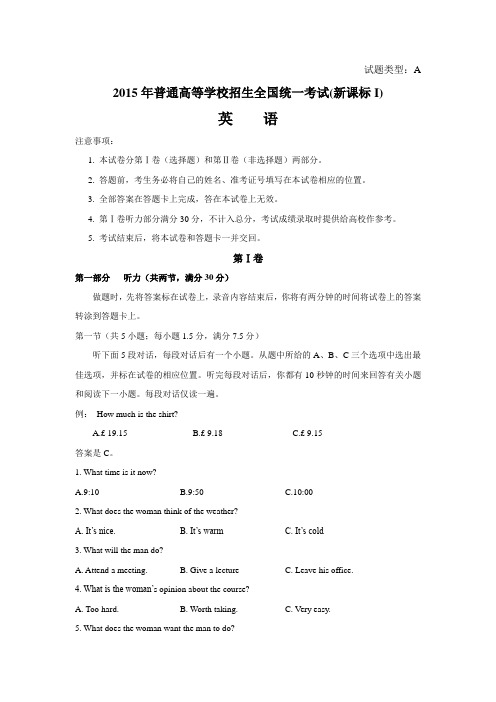
试题类型:A 2015年普通高等学校招生全国统一考试(新课标I)英语注意事项:1. 本试卷分第Ⅰ卷(选择题)和第Ⅱ卷(非选择题)两部分。
2. 答题前,考生务必将自己的姓名、准考证号填写在本试卷相应的位置。
3. 全部答案在答题卡上完成,答在本试卷上无效。
4. 第Ⅰ卷听力部分满分30分,不计入总分,考试成绩录取时提供给高校作参考。
5. 考试结束后,将本试卷和答题卡一并交回。
第Ⅰ卷第一部分听力(共两节,满分30分)做题时,先将答案标在试卷上,录音内容结束后,你将有两分钟的时间将试卷上的答案转涂到答题卡上。
第一节(共5小题;每小题1.5分,满分7.5分)听下面5段对话,每段对话后有一个小题。
从题中所给的A、B、C三个选项中选出最佳选项,并标在试卷的相应位置。
听完每段对话后,你都有10秒钟的时间来回答有关小题和阅读下一小题。
每段对话仅读一遍。
例:How much is the shirt?A.£ 19.15B.£ 9.18C.£ 9.15答案是C。
1. What time is it now?A.9:10B.9:50C.10:002. What does the woman think of the weather?A. It’s nice.B. It’s warmC. It’s cold3. What will the man do?A. Attend a meeting.B. Give a lectureC. Leave his office.4. What is the woman’s opinion about the course?A. Too hard.B. Worth taking.C. Very easy.5. What does the woman want the man to do?A. Speak louder.B. Apologize to her.C. Turn off the radio.第二节(共15小题;每小题1.5分,满分22.5分)听下面5段对话或独白。
2015高考英语全国卷1.新课标及答案

绝密★启用前2015年普通高等学校招生全国统一考试(全国卷1。
新课标)英语注意事项:1。
本试卷分第Ⅰ卷(选择题)和第Ⅱ卷(非选择题)两部分. 第Ⅰ卷1页至10页,第Ⅱ卷11页至13页。
2。
答题前,考生务必将自己的姓名,准考证号填写在本试卷相应的位置。
3。
全部答案在答题卡上完成,搭载本试卷上无效。
4. 第Ⅰ卷听力部分满分30分,不计入总分,考试成绩录取时提供给高校作参考.5。
考试结束后,将本试卷和答题卡一并交回.第Ⅰ卷第一部分听力(共两节,满分30分)做题时,现将答案标在试卷上,录音内容结束后,你将有两分钟的时间将试卷上的答案转涂到答题卡上。
第一节(共5小题;每小题1。
5分,满分7。
5分)听下面5段对话,每段对话后有一个小题. 从题中所给的A,B,C三个选项中选出最佳选项,并标在试卷的相应位置。
听完每段对话后,你都有10秒钟的时间来回答有关小题和阅读下一小题. 每段对话仅读一遍.例:How much is the shirt?A.£ 19。
15B.£ 9。
18C.£ 9.15答案是C1. What time is it now?A。
9:10. B。
9:50。
C. 10:00.2. What does the woman think of the weather?A。
It’s nice。
B. It’s warm。
C. It’s cold.3. What will the man do?A。
Attend a meeting. B。
Give a lecture. C. Leave his office。
4。
What is the woman's opinion about the course?A. Too hard。
B. Worth taking.C. V ery easy.5。
What does the woman want the man do?A。
Speak louder。
2015年全国高考英语试题i卷及答案

2015年全国高考英语试题i卷及答案听力部分第一节(共5小题,每小题1.5分,满分7.5分)1. A: What time is it now?B: It's 8:30.Question: What time is it?Answer: It's 8:30.2. A: I heard you got a new job. Congratulations!B: Thanks, I start next week.Question: When does the man start his new job?Answer: Next week.3. A: Would you like to go to the concert tonight?B: I'd love to, but I have to finish my report first.Question: What does the woman mean?Answer: She needs to finish her report.4. A: I'm going to the library. Do you want to come with me? B: No, thanks. I'll stay at home and watch a movie.Question: What will the man do?Answer: Stay at home and watch a movie.5. A: I can't find my keys. I must have left them in the office.B: Well, you should go back and get them.Question: What does the woman advise the man to do?Answer: Go back and get the keys.第二节(共15小题,每小题1.5分,满分22.5分)6-10. [略](根据实际听力材料填写)11-15. [略](根据实际听力材料填写)笔试部分第一节阅读理解(共20小题,每小题2分,满分40分)AIn recent years, the number of people who prefer to work at home has been increasing. Home-based workers are able to save time, reduce stress, and enjoy a better work-life balance. However, there are also some challenges they face, such as isolation and lack of motivation.21. What is the main idea of the passage?Answer: The benefits and challenges of working at home.B[略](根据实际阅读材料填写)22-25. [略](根据实际阅读材料填写)C[略](根据实际阅读材料填写)26-30. [略](根据实际阅读材料填写)第二节英语知识运用(共20小题,每小题1.5分,满分30分)31. The teacher asked the students to write a report,________ they were not interested in.Answer: where32. [略](根据实际语法填空材料填写)33-50. [略](根据实际语法填空材料填写)第三节写作(满分35分)51. Write an essay of 120 words based on the picture provided. (Changes in people's lifestyles)Answer: [略](根据实际写作要求和图画内容填写)结束语以上是2015年全国高考英语试题i卷及答案的示例。
- 1、下载文档前请自行甄别文档内容的完整性,平台不提供额外的编辑、内容补充、找答案等附加服务。
- 2、"仅部分预览"的文档,不可在线预览部分如存在完整性等问题,可反馈申请退款(可完整预览的文档不适用该条件!)。
- 3、如文档侵犯您的权益,请联系客服反馈,我们会尽快为您处理(人工客服工作时间:9:00-18:30)。
2015年普通高等学校招生全国统一考试(全国卷·课标I卷)
英语
本试卷分第I卷(选择题)和第II卷(非选择题)两部分,考试结束后,将本试卷和答题卡一并交回。
注意事项:
1. 答第I卷前,考生务必将自己的姓名、考生号填写在答题卡上。
2. 选出每小题答案后,用铅笔把答题卡上对应题目的答案标号涂黑。
如需改动,用橡皮擦干净后,再选涂其他答案标号。
不能答在本试卷上,否则无效。
第一部分听力(共两节, 满分30分)
做题时,先将答案标在试卷上。
录音内容结束后,你将有两分钟的时间将试卷上的答案转涂到答题卡上。
第一节(共5小题;每小题1.5分,满分7.5分)
听下面5段对话。
每段对话后有一个小题,从题中所给的A、B、C三个选项中选出最佳选项,并标在试卷的相应位置。
听完每段对话后,你都有10称钟的时间来回答有关小题和阅读下一小题。
每段对话仅读一遍。
例:How much is the shirt?A.£19.15.ﻩB.£9.18. ﻩC.£9.15.答案是C。
1.What time isitnow?
A. 9:10.
B. 9:50.
C. 10:00.
2. What does the womanthink of the weather?
A.It’s nice.
B.It’swarm.
C. It’s cold.
3. Whatwill the mando?
A.Attend ameeting.ﻩB.Givealecture.ﻩC. Leave his office.
4. What is the woman’sopinion about the course?
A. Too hard.ﻩB. Worthtaking.ﻩC. Veryeasy.
5. Whatdoes the womanwant the man do?
A. Speak louder.
B. Apologize to her.ﻩ
C. Turn off the radio.
第二节(共15小题;每小题1.5分,满分22.5分)
听下面5段对话或独白。
每段对话或独白后有几个小题,从题中所给的A、B、C三个选项中选出最
佳选项,并标在试卷的相应位置。
听每段对话或独白前,你将有时间阅读各个小题,每小题5秒钟;听完后,
各小题将给出5秒钟的作答时间。
每段对话或独白读两遍。
听第6段材料,回答第6、7题。
6.How long did Michael stay in China?
A.Five days.ﻩB. One week.ﻩC. Two weeks.
7. Where did Michael golast year?
A.Russia.ﻩB. Norway.ﻩC. India.
听第7段材料,回答第8、9题。
8. What food does Sally like?
ﻩA. Chicken. B.Fish. C. Eggs.
9.Whatare the speakers going todo?
A.Cook dinner. B. Go shopping. C.Order dishes. 听第8段材料,回答第10至12题。
10. Where are the speakers?
ﻩA.In a hospital. B. Intheoffice.ﻩC. At home.
11. When is the report due?
ﻩA.Thursday. B.Friday. C. NextMonday.12.What doesGeorge suggest Stephanie do withthe report?
A. Improve it. B.Hand it in later.ﻩC.Leave it with him.
听第9段材料,回答第13至16题。
13.Whatis the probablerelationship between the speakers?
A.Salespersonand customer. ﻩ
B. Homeowner and cleaner.
ﻩC. Husband and wife.
14.What kindof apartment do the speakers prefer?
A.Onewith two bedrooms. ﻩB.Onewithout furniture.ﻩC. On enear a market.
15.How much rent should onepay fortheone-bedroomapartment? ﻩA.$350. B.$400. ﻩC.$415.
16.Whereis theapartment the speakers wouldlike tosee?
ﻩA.OnLake Street. ﻩB.On Market. C.OnSouth S treet.
听第10段材料,回答第17至20题。
17.What percentage of theworld’steaexports go to Britain?
ﻩA. Almost 15%. B.About 30%. C. Over 40%.
18.Why do tea tasterstaste tea withmilk?
ﻩA.Most British people drink tea that way.
B. Tea tastes muchbetterwith milk.
ﻩC. Tea with milk is healthy.
19.Who suggestsa price foreachtea?
ﻩA. Tea tasters.ﻩB.Tea exporters. C. Teacompanies.
20.What is thespeakertalkingabout?
A. Thelife oftea tasters.ﻩB. Afternoon tea in Britain.
ﻩC.The London Tea TradeCentre.
第二部分阅读理解(共两节,满分40分)
第一节(共15小题;每小题2分,满分30分)
阅读下列短文,从每题所给的四个选项(A、B、C、和D)中,选出最佳选项,并在答题卡上将该项涂黑。
A
Monthly Talks at London Canal Museum
Ourmonthlytalks start at 19:30 on the first Thursday ofeach。
